brake light FIAT 500C 2019 User Guide
[x] Cancel search | Manufacturer: FIAT, Model Year: 2019, Model line: 500C, Model: FIAT 500C 2019Pages: 332, PDF Size: 3.17 MB
Page 166 of 332
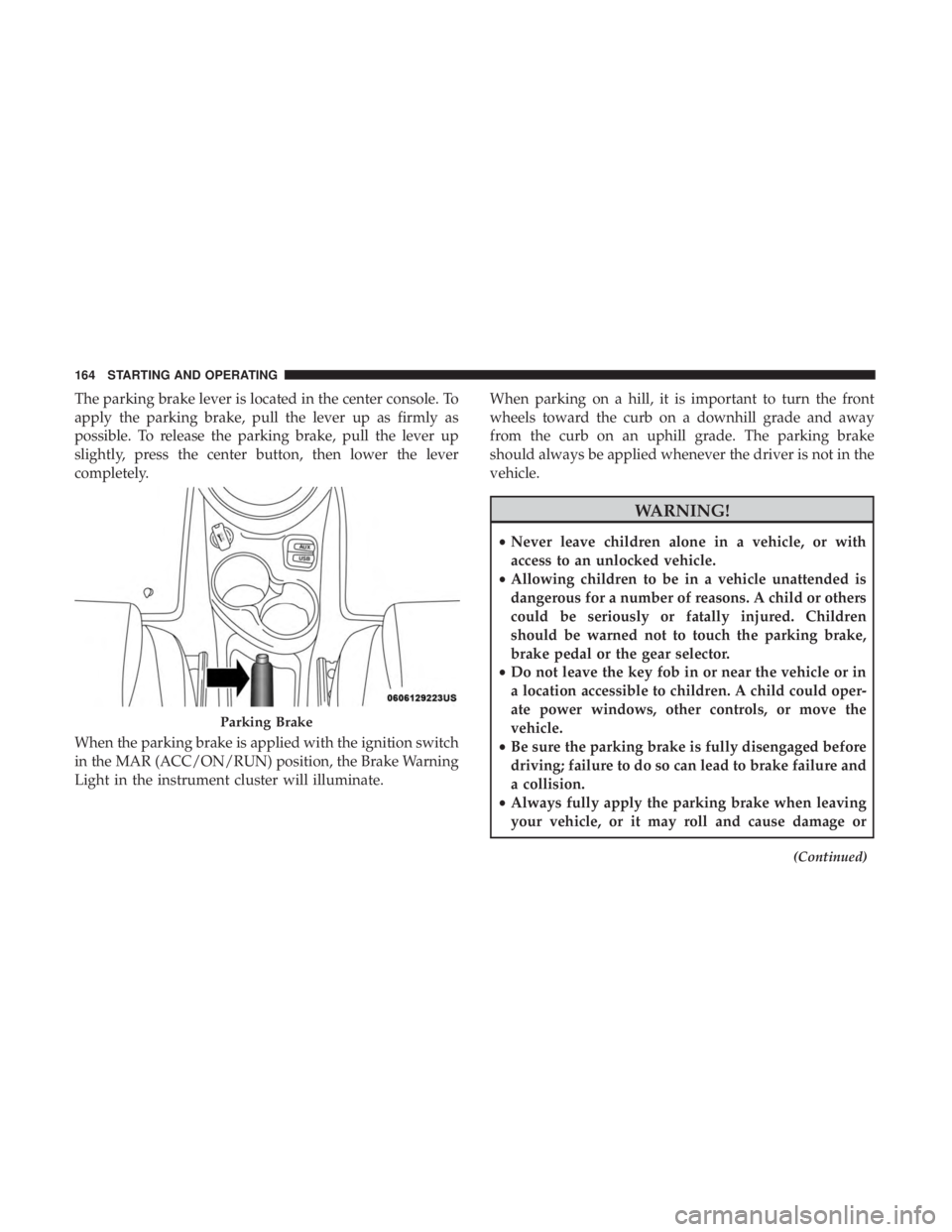
The parking brake lever is located in the center console. To
apply the parking brake, pull the lever up as firmly as
possible. To release the parking brake, pull the lever up
slightly, press the center button, then lower the lever
completely.
When the parking brake is applied with the ignition switch
in the MAR (ACC/ON/RUN) position, the Brake Warning
Light in the instrument cluster will illuminate.When parking on a hill, it is important to turn the front
wheels toward the curb on a downhill grade and away
from the curb on an uphill grade. The parking brake
should always be applied whenever the driver is not in the
vehicle.
WARNING!
•
Never leave children alone in a vehicle, or with
access to an unlocked vehicle.
• Allowing children to be in a vehicle unattended is
dangerous for a number of reasons. A child or others
could be seriously or fatally injured. Children
should be warned not to touch the parking brake,
brake pedal or the gear selector.
• Do not leave the key fob in or near the vehicle or in
a location accessible to children. A child could oper-
ate power windows, other controls, or move the
vehicle.
• Be sure the parking brake is fully disengaged before
driving; failure to do so can lead to brake failure and
a collision.
• Always fully apply the parking brake when leaving
your vehicle, or it may roll and cause damage or
(Continued)
Parking Brake
164 STARTING AND OPERATING
Page 167 of 332
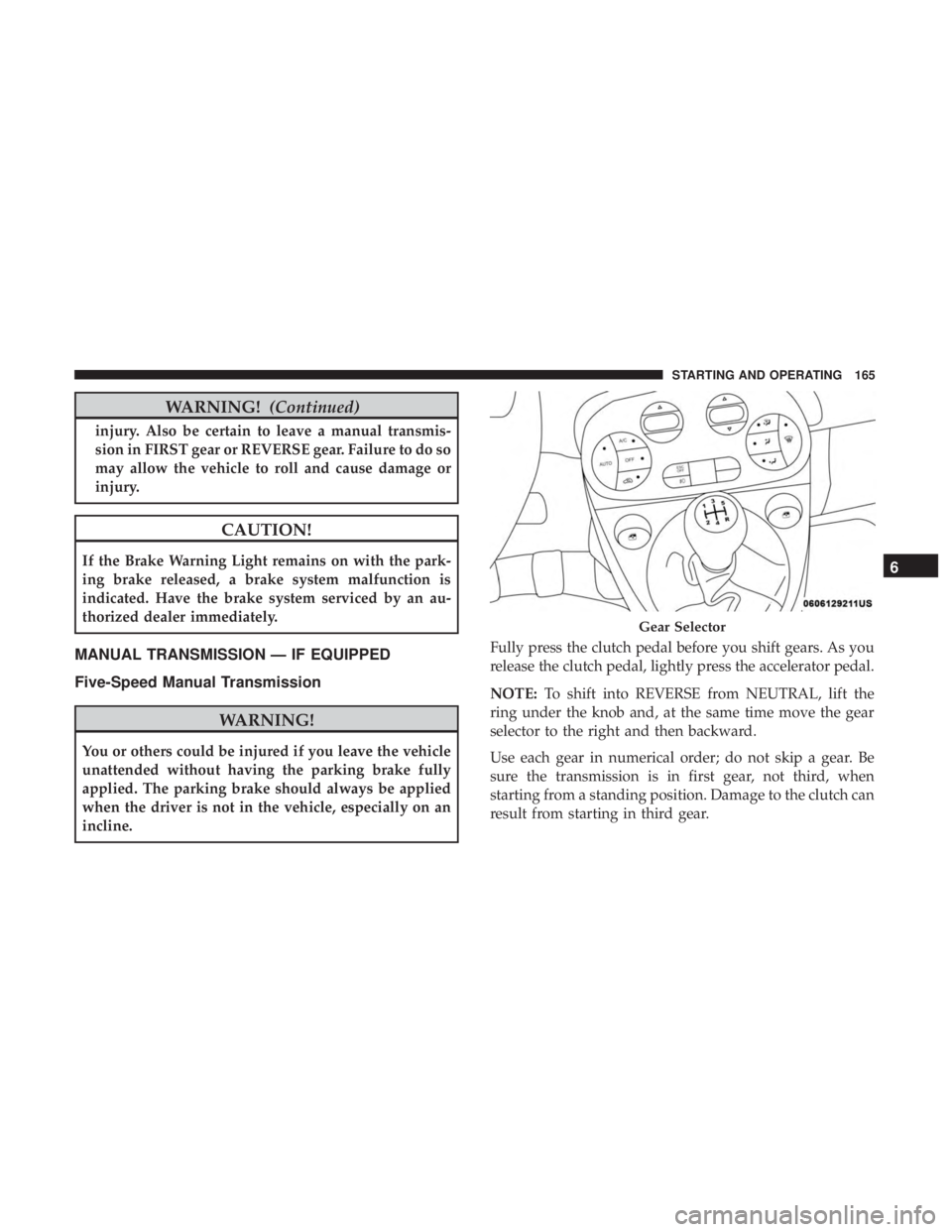
WARNING!(Continued)
injury. Also be certain to leave a manual transmis-
sion in FIRST gear or REVERSE gear. Failure to do so
may allow the vehicle to roll and cause damage or
injury.
CAUTION!
If the Brake Warning Light remains on with the park-
ing brake released, a brake system malfunction is
indicated. Have the brake system serviced by an au-
thorized dealer immediately.
MANUAL TRANSMISSION — IF EQUIPPED
Five-Speed Manual Transmission
WARNING!
You or others could be injured if you leave the vehicle
unattended without having the parking brake fully
applied. The parking brake should always be applied
when the driver is not in the vehicle, especially on an
incline. Fully press the clutch pedal before you shift gears. As you
release the clutch pedal, lightly press the accelerator pedal.
NOTE:
To shift into REVERSE from NEUTRAL, lift the
ring under the knob and, at the same time move the gear
selector to the right and then backward.
Use each gear in numerical order; do not skip a gear. Be
sure the transmission is in first gear, not third, when
starting from a standing position. Damage to the clutch can
result from starting in third gear.
Gear Selector
6
STARTING AND OPERATING 165
Page 194 of 332
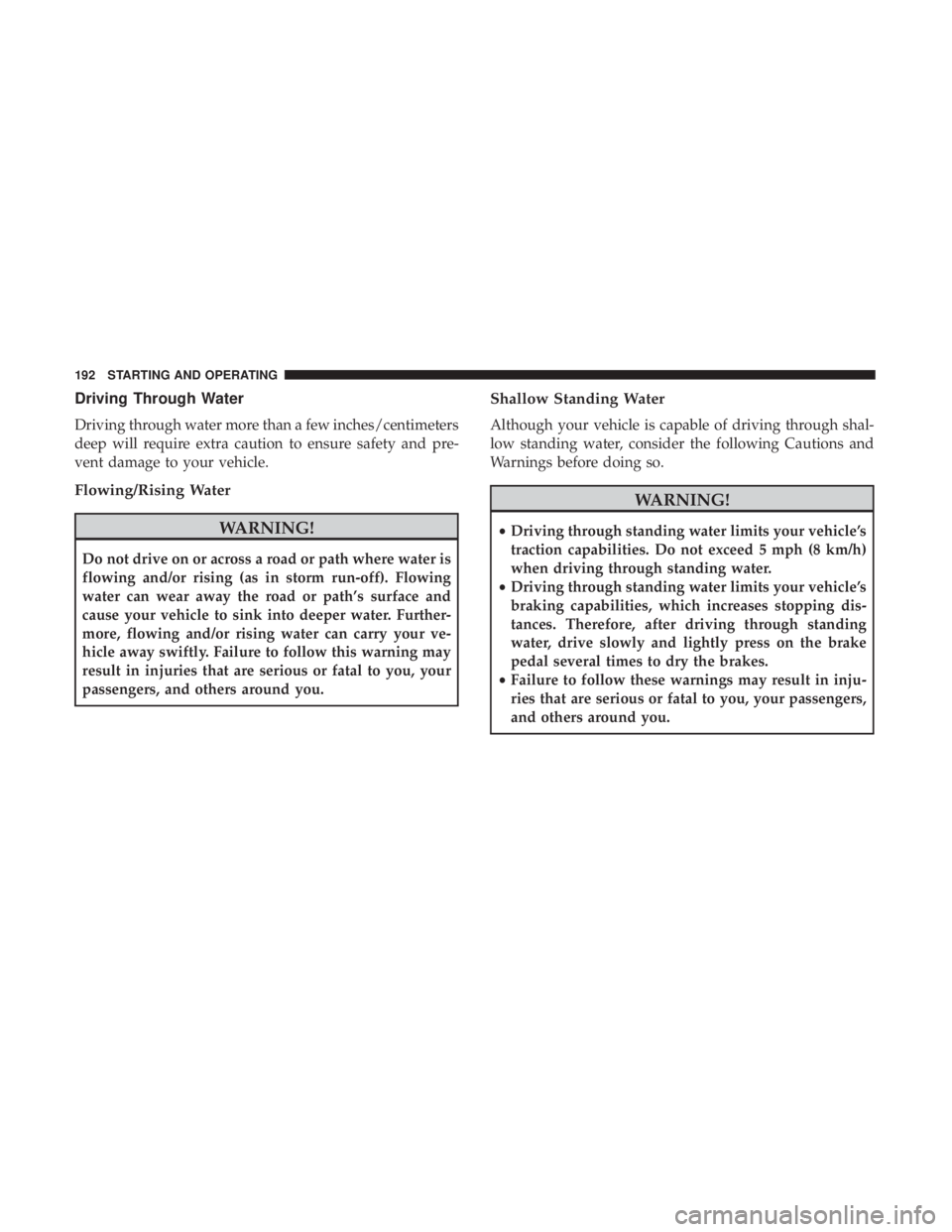
Driving Through Water
Driving through water more than a few inches/centimeters
deep will require extra caution to ensure safety and pre-
vent damage to your vehicle.
Flowing/Rising Water
WARNING!
Do not drive on or across a road or path where water is
flowing and/or rising (as in storm run-off). Flowing
water can wear away the road or path’s surface and
cause your vehicle to sink into deeper water. Further-
more, flowing and/or rising water can carry your ve-
hicle away swiftly. Failure to follow this warning may
result in injuries that are serious or fatal to you, your
passengers, and others around you.
Shallow Standing Water
Although your vehicle is capable of driving through shal-
low standing water, consider the following Cautions and
Warnings before doing so.
WARNING!
•Driving through standing water limits your vehicle’s
traction capabilities. Do not exceed 5 mph (8 km/h)
when driving through standing water.
• Driving through standing water limits your vehicle’s
braking capabilities, which increases stopping dis-
tances. Therefore, after driving through standing
water, drive slowly and lightly press on the brake
pedal several times to dry the brakes.
• Failure to follow these warnings may result in inju-
ries that are serious or fatal to you, your passengers,
and others around you.
192 STARTING AND OPERATING
Page 228 of 332
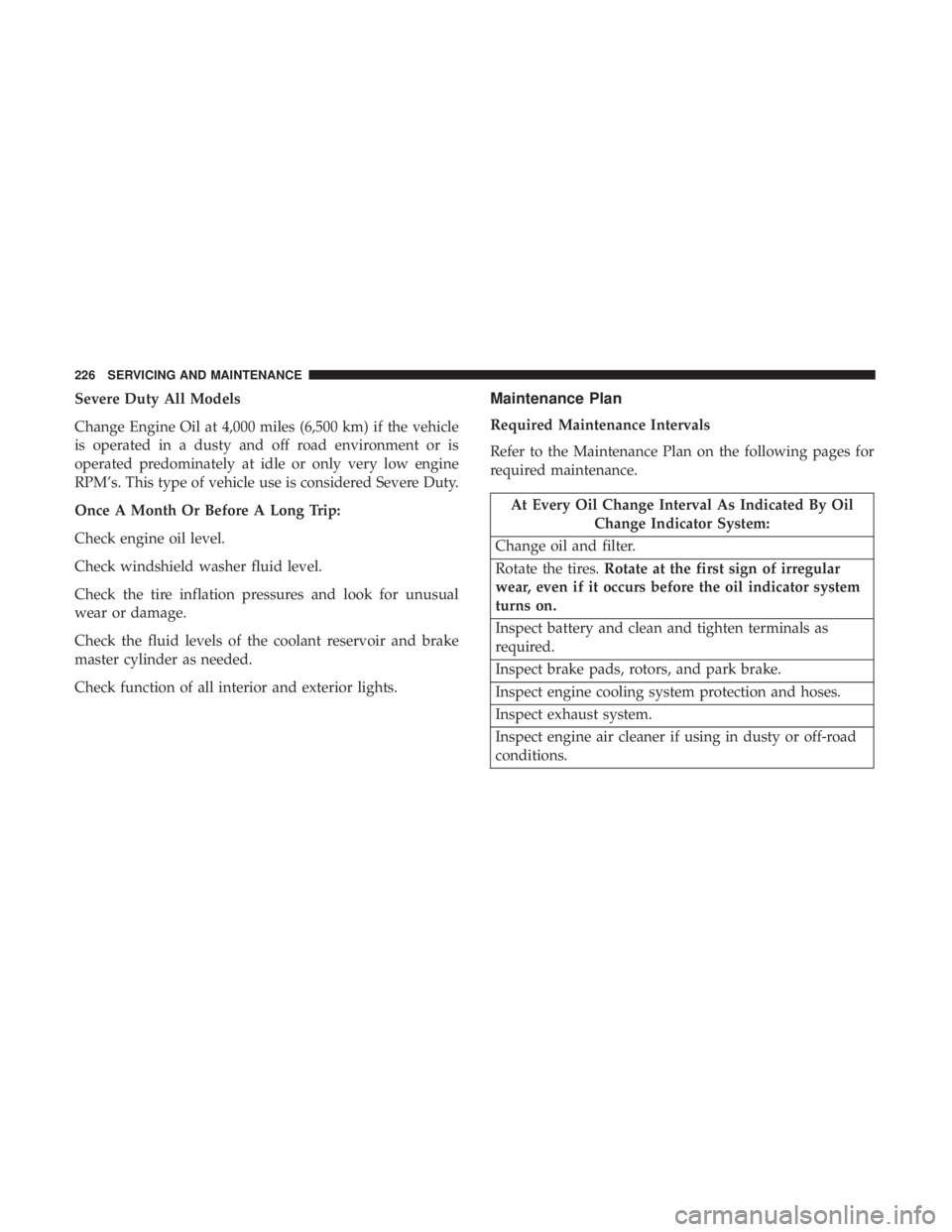
Severe Duty All Models
Change Engine Oil at 4,000 miles (6,500 km) if the vehicle
is operated in a dusty and off road environment or is
operated predominately at idle or only very low engine
RPM’s. This type of vehicle use is considered Severe Duty.
Once A Month Or Before A Long Trip:
Check engine oil level.
Check windshield washer fluid level.
Check the tire inflation pressures and look for unusual
wear or damage.
Check the fluid levels of the coolant reservoir and brake
master cylinder as needed.
Check function of all interior and exterior lights.Maintenance Plan
Required Maintenance Intervals
Refer to the Maintenance Plan on the following pages for
required maintenance.
At Every Oil Change Interval As Indicated By OilChange Indicator System:
Change oil and filter.
Rotate the tires. Rotate at the first sign of irregular
wear, even if it occurs before the oil indicator system
turns on.
Inspect battery and clean and tighten terminals as
required.
Inspect brake pads, rotors, and park brake.
Inspect engine cooling system protection and hoses.
Inspect exhaust system.
Inspect engine air cleaner if using in dusty or off-road
conditions.
226 SERVICING AND MAINTENANCE
Page 249 of 332
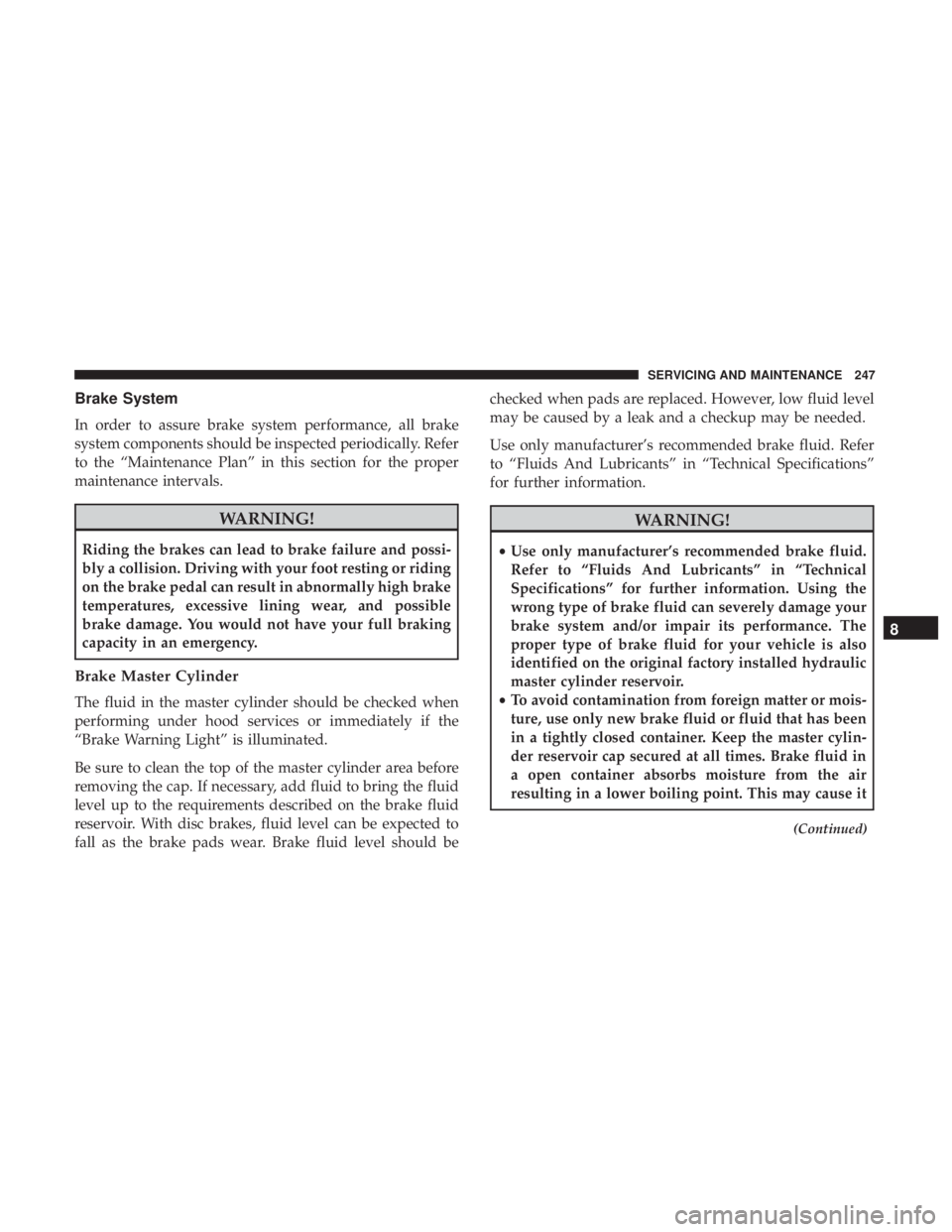
Brake System
In order to assure brake system performance, all brake
system components should be inspected periodically. Refer
to the “Maintenance Plan” in this section for the proper
maintenance intervals.
WARNING!
Riding the brakes can lead to brake failure and possi-
bly a collision. Driving with your foot resting or riding
on the brake pedal can result in abnormally high brake
temperatures, excessive lining wear, and possible
brake damage. You would not have your full braking
capacity in an emergency.
Brake Master Cylinder
The fluid in the master cylinder should be checked when
performing under hood services or immediately if the
“Brake Warning Light” is illuminated.
Be sure to clean the top of the master cylinder area before
removing the cap. If necessary, add fluid to bring the fluid
level up to the requirements described on the brake fluid
reservoir. With disc brakes, fluid level can be expected to
fall as the brake pads wear. Brake fluid level should bechecked when pads are replaced. However, low fluid level
may be caused by a leak and a checkup may be needed.
Use only manufacturer’s recommended brake fluid. Refer
to “Fluids And Lubricants” in “Technical Specifications”
for further information.
WARNING!
•
Use only manufacturer’s recommended brake fluid.
Refer to “Fluids And Lubricants” in “Technical
Specifications” for further information. Using the
wrong type of brake fluid can severely damage your
brake system and/or impair its performance. The
proper type of brake fluid for your vehicle is also
identified on the original factory installed hydraulic
master cylinder reservoir.
• To avoid contamination from foreign matter or mois-
ture, use only new brake fluid or fluid that has been
in a tightly closed container. Keep the master cylin-
der reservoir cap secured at all times. Brake fluid in
a open container absorbs moisture from the air
resulting in a lower boiling point. This may cause it
(Continued)
8
SERVICING AND MAINTENANCE 247
Page 282 of 332
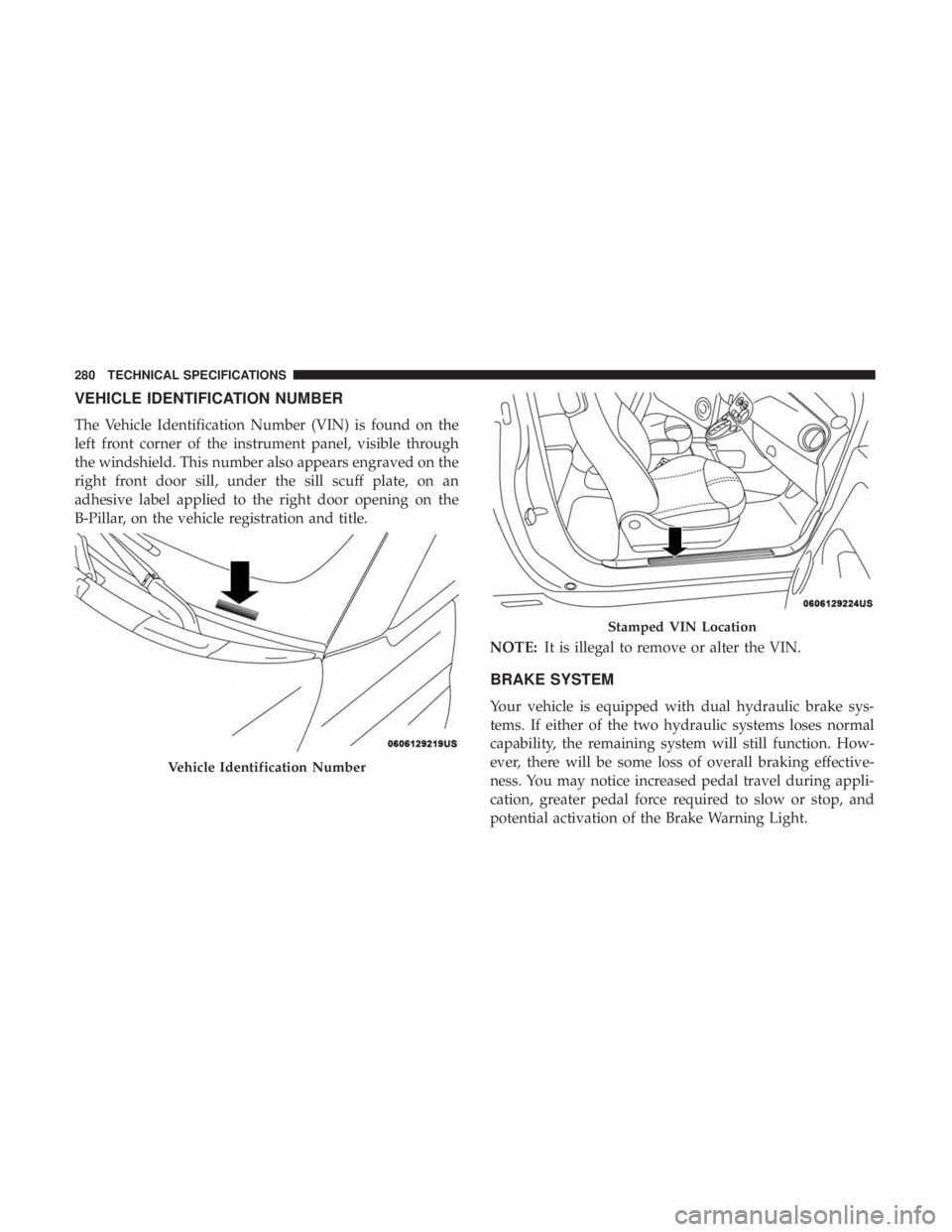
VEHICLE IDENTIFICATION NUMBER
The Vehicle Identification Number (VIN) is found on the
left front corner of the instrument panel, visible through
the windshield. This number also appears engraved on the
right front door sill, under the sill scuff plate, on an
adhesive label applied to the right door opening on the
B-Pillar, on the vehicle registration and title.NOTE:It is illegal to remove or alter the VIN.
BRAKE SYSTEM
Your vehicle is equipped with dual hydraulic brake sys-
tems. If either of the two hydraulic systems loses normal
capability, the remaining system will still function. How-
ever, there will be some loss of overall braking effective-
ness. You may notice increased pedal travel during appli-
cation, greater pedal force required to slow or stop, and
potential activation of the Brake Warning Light.
Vehicle Identification Number
Stamped VIN Location
280 TECHNICAL SPECIFICATIONS
Page 318 of 332
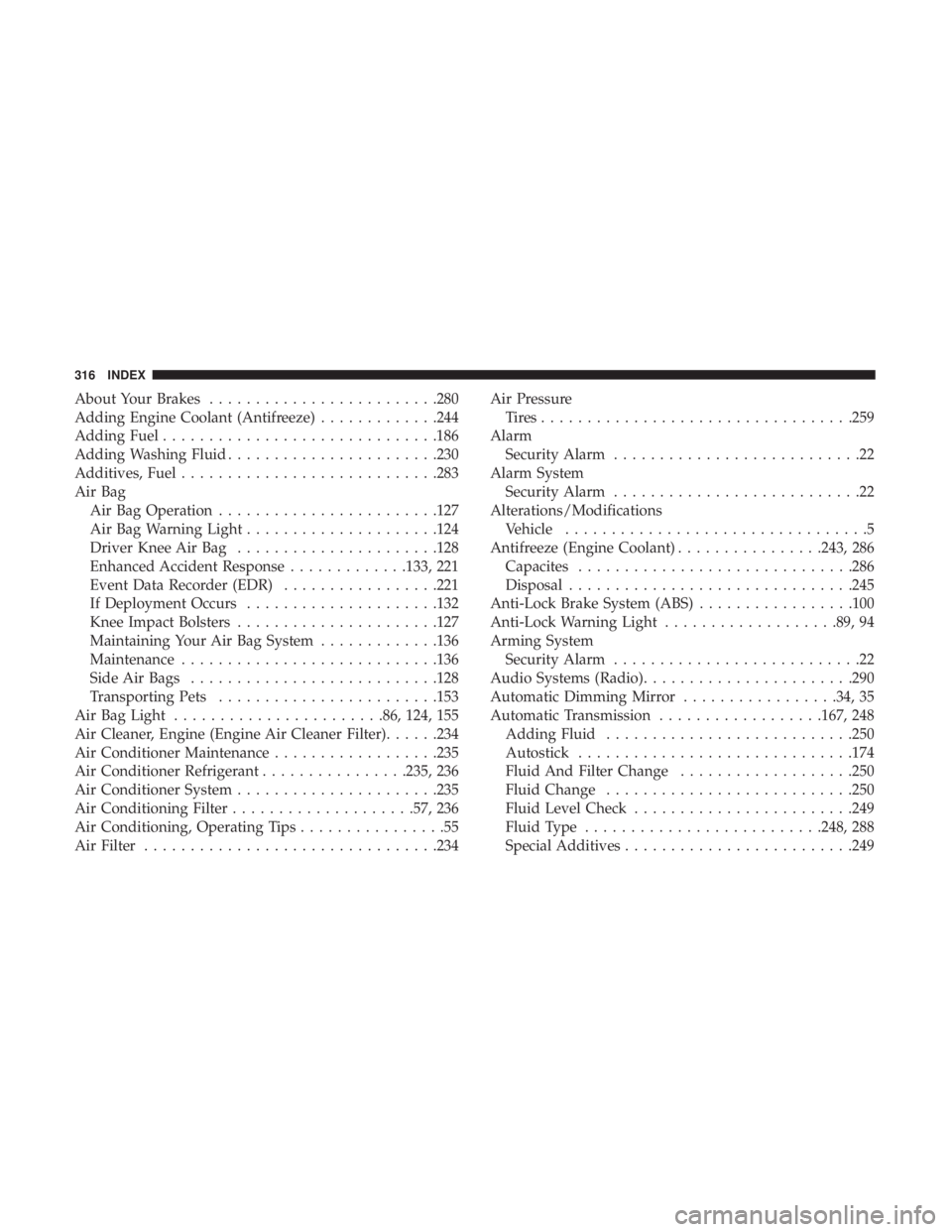
About Your Brakes........................ .280
Adding Engine Coolant (Antifreeze) .............244
Adding Fuel ............................. .186
Adding Washing Fluid ...................... .230
Additives, Fuel ........................... .283
Air Bag Air Bag Operation ....................... .127
Air Bag Warning Light .....................124
Driver Knee Air Bag ..................... .128
Enhanced Accident Response .............133, 221
Event Data Recorder (EDR) .................221
If Deployment Occurs .....................132
Knee Impact Bolsters ..................... .127
Maintaining Your Air Bag System .............136
Maintenance ........................... .136
Side Air Bags .......................... .128
Transporting Pets ....................... .153
Air Bag Light ...................... .86, 124, 155
Air Cleaner, Engine (Engine Air Cleaner Filter) ......234
Air Conditioner Maintenance ..................235
Air Conditioner Refrigerant ................235, 236
Air Conditioner System ..................... .235
Air Conditioning Filter ....................57, 236
Air Conditioning, Operating Tips ................55
Air Filter ............................... .234Air Pressure
Tires................................. .259
Alarm Security Alarm ...........................22
Alarm System Security Alarm ...........................22
Alterations/Modifications Vehicle .................................5
Antifreeze (Engine Coolant) ................243, 286
Capacites ............................. .286
Disposal .............................. .245
Anti-Lock Brake System (ABS) .................100
Anti-Lock Warning Light ...................89, 94
Arming System Security Alarm ...........................22
Audio
Systems (Radio) ...................... .290
Automatic Dimming Mirror .................34, 35
Automatic Transmission ..................167, 248
Adding Fluid .......................... .250
Autostick ............................. .174
Fluid And Filter Change ...................250
Fluid Change .......................... .250
Fluid Level Check ....................... .249
Fluid Type ......................... .248, 288
Special Additives ........................ .249
316 INDEX
Page 319 of 332
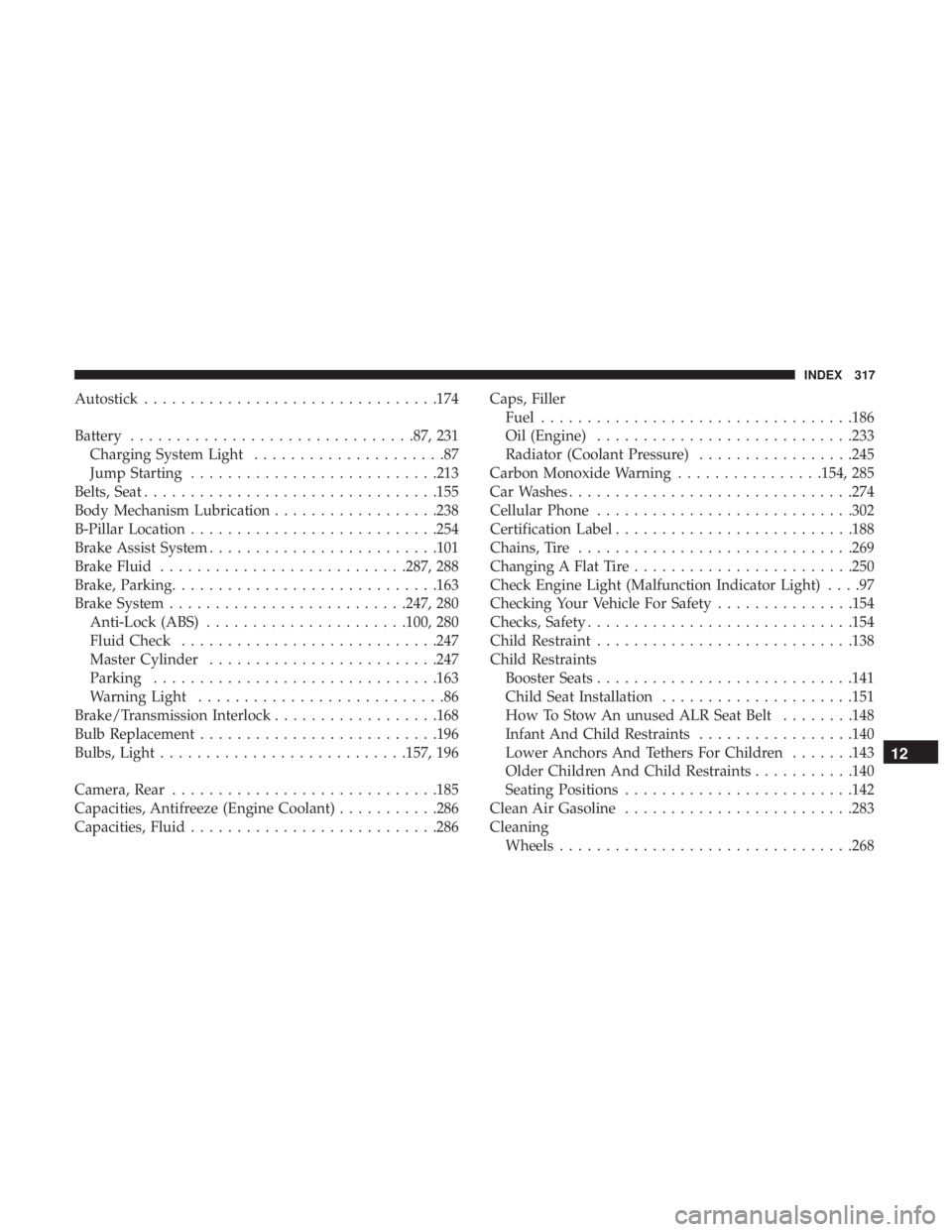
Autostick............................... .174
Battery .............................. .87, 231
Charging System Light .....................87
Jump Starting .......................... .213
Belts, Seat ............................... .155
Body Mechanism Lubrication ..................238
B-Pillar Location .......................... .254
Brake Assist System ........................ .101
Brake Fluid .......................... .287, 288
Brake, Parking ............................ .163
Brake System ......................... .247, 280
Anti-Lock (ABS) ..................... .100, 280
Fluid Check ........................... .247
Master Cylinder ........................ .247
Parking .............................. .163
Warning Light ...........................86
Brake/Transmission Interlock ..................168
Bulb Replacement ......................... .196
Bulbs, Light .......................... .157, 196
Camera, Rear ............................ .185
Capacities, Antifreeze (Engine Coolant) ...........286
Capacities, Fluid .......................... .286Caps, Filler
Fuel ................................. .186
Oil (Engine) ........................... .233
Radiator (Coolant Pressure) .................245
Carbon Monoxide Warning ................154, 285
Car Washes .............................. .274
Cellular Phone ........................... .302
Certification Label ......................... .188
Chains, Tire ............................. .269
Changing A Flat Tire ....................... .250
Check Engine Light (Malfunction Indicator Light) ....97
Checking Your Vehicle For Safety ...............154
Checks, Safety ............................ .154
Child Restraint ........................... .138
Child
Restraints
Booster Seats ........................... .141
Child Seat Installation .....................151
How To Stow An unused ALR Seat Belt ........148
Infant And Child Restraints .................140
Lower Anchors And Tethers For Children .......143
Older Children And Child Restraints ...........140
Seating Positions ........................ .142
Clean Air Gasoline ........................ .283
Cleaning Wheels ............................... .268
12
INDEX 317
Page 320 of 332
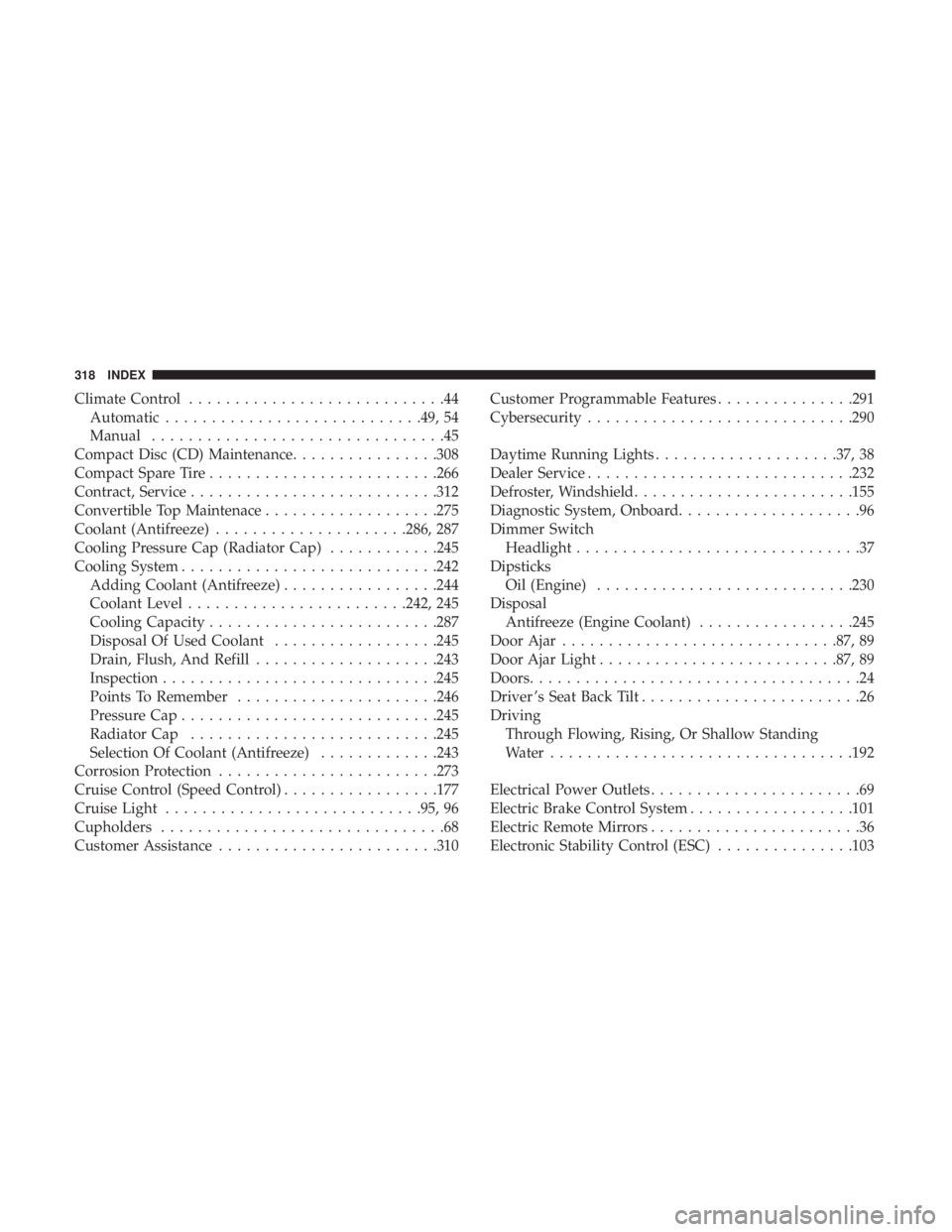
Climate Control............................44
Automatic ........................... .49, 54
Manual ................................45
Compact Disc (CD) Maintenance ................308
Compact Spare Tire ........................ .266
Contract, Service .......................... .312
Convertible Top Maintenace ...................275
Coolant (Antifreeze) .....................286, 287
Cooling Pressure Cap (Radiator Cap) ............245
Cooling System ........................... .242
Adding Coolant (Antifreeze) .................244
Coolant Level ....................... .242, 245
Cooling Capacity ........................ .287
Disposal Of Used Coolant ..................245
Drain, Flush, And Refill ....................243
Inspection ............................. .245
Points To Remember ..................... .246
Pressure Cap ........................... .245
Radiator Cap .......................... .245
Selection Of Coolant (Antifreeze) .............243
Corrosion Protection ....................... .273
Cruise Control (Speed Control) .................177
Cruise Light ........................... .95, 96
Cupholders ...............................68
Customer Assistance ....................... .310Customer Programmable Features
...............291
Cybersecurity ............................ .290
Daytime Running Lights ....................37, 38
Dealer Service ............................ .232
Defroster, Windshield ....................... .155
Diagnostic System, Onboard ....................96
Dimmer Switch Headlight ...............................37
Dipsticks Oil (Engine) ........................... .230
Disposal Antifreeze (Engine Coolant) .................245
Door Ajar ............................. .87,
89
Door Ajar Light ......................... .87, 89
Doors ....................................24
Driver ’s Seat Back Tilt ........................26
Driving Through Flowing, Rising, Or Shallow Standing
Water ................................ .192
Electrical Power Outlets .......................69
Electric Brake Control System ..................101
Electric Remote Mirrors .......................36
Electronic Stability Control (ESC) ...............103
318 INDEX
Page 321 of 332
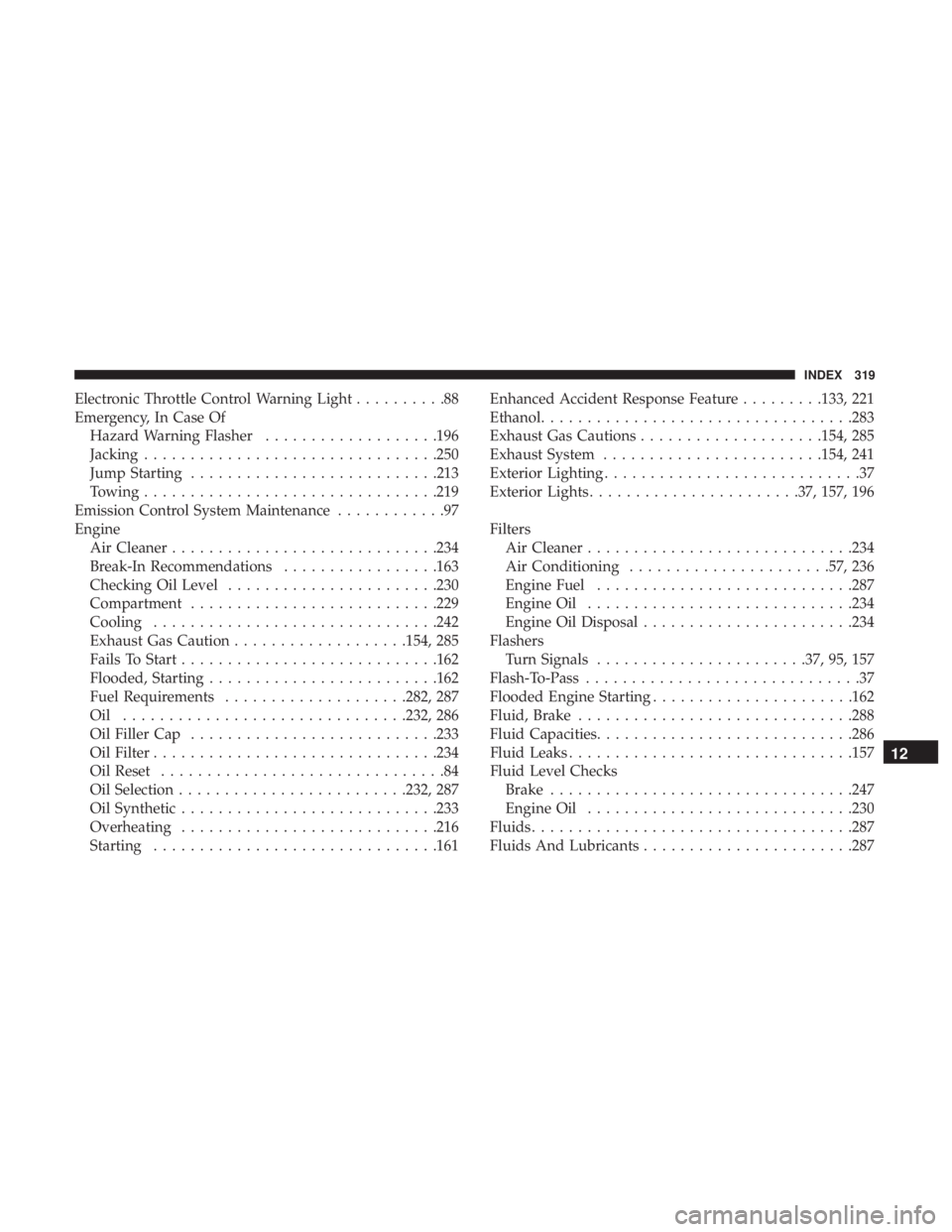
Electronic Throttle Control Warning Light..........88
Emergency, In Case Of Hazard Warning Flasher ...................196
Jacking ............................... .250
Jump Starting .......................... .213
Towing ............................... .219
Emission Control System Maintenance ............97
Engine Air Cleaner ............................ .234
Break-In Recommendations .................163
Checking Oil Level ...................... .230
Compartment .......................... .229
Cooling .............................. .242
Exhaust Gas Caution ...................154, 285
Fails To Start ........................... .162
Flooded, Starting ........................ .162
Fuel Requirements ....................282, 287
Oil .............................. .232, 286
Oil Filler Cap .......................... .233
Oil Filter .............................. .234
Oil Reset ...............................84
Oil Selection ........................ .232, 287
Oil Synthetic ........................... .233
Overheating ........................... .216
Starting .............................. .161Enhanced Accident Response Feature
.........133, 221
Ethanol ................................. .283
Exhaust Gas Cautions ....................154, 285
Exhaust System ....................... .154, 241
Exterior Lighting ............................37
Exterior Lights ...................... .37, 157, 196
Filters Air Cleaner ............................ .234
Air Conditioning ..................... .57, 236
Engine Fuel ........................... .287
Engine Oil ............................ .234
Engine Oil Disposal ...................... .234
Flashers Turn Signals ...................... .37,
95, 157
Flash-To-Pass ..............................37
Flooded Engine Starting ..................... .162
Fluid, Brake ............................. .288
Fluid Capacities ........................... .286
Fluid Leaks .............................. .157
Fluid Level Checks Brake ................................ .247
Engine Oil ............................ .230
Fluids .................................. .287
Fluids And Lubricants ...................... .287
12
INDEX 319